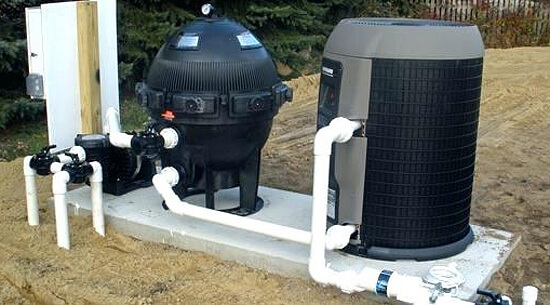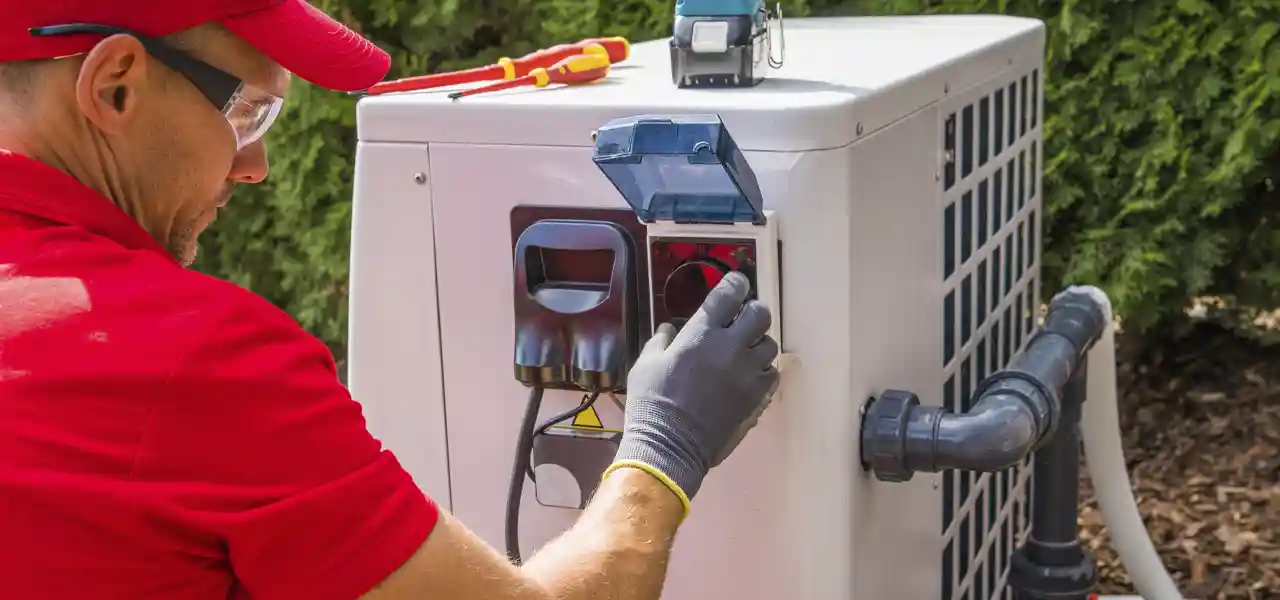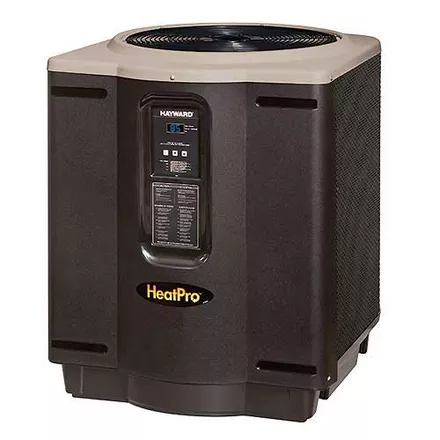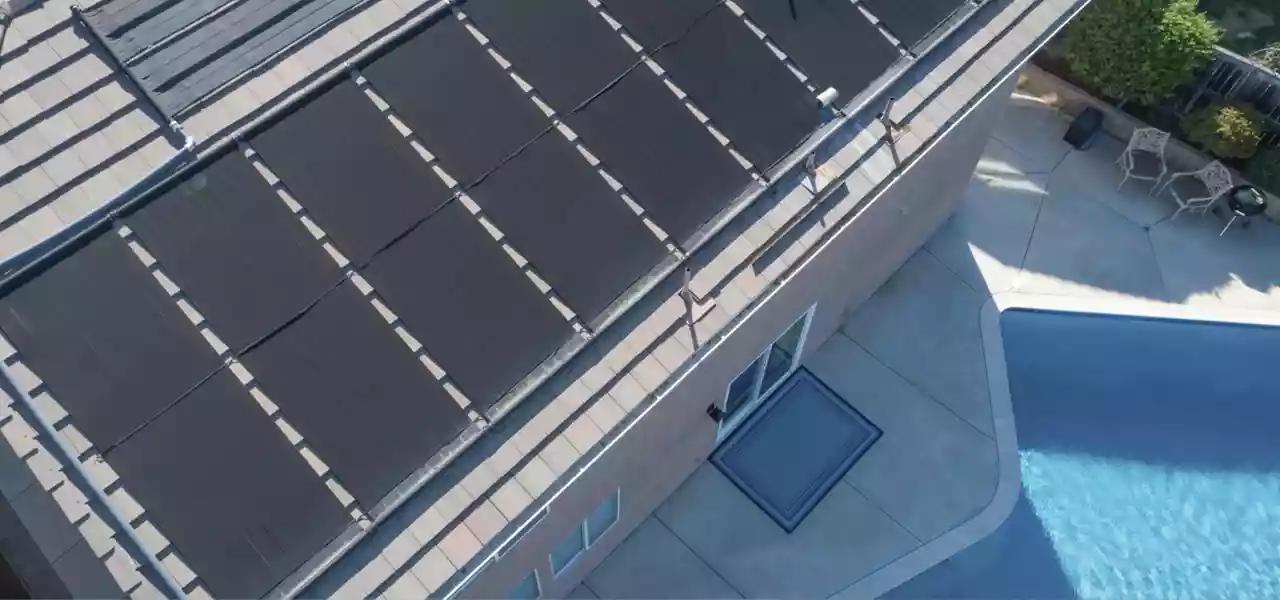A pool heat pump is the best choice for economical, on-demand pool heating. Sure, gas heats faster, but even at today’s lower prices, a gas pool heater can burn through thousands of dollars in natural or propane gas every year.
Pool heat pumps use small amounts of electricity to compress a refrigerant and rotate a fan. The heat created is essentially free, absorbed from the outside air and transferred into your pool water.
The 4 Ps of Pool Heat Pump Installation
Here’s an example of a heat pump project progression. The 4 Ps are phases of a swimming pool heat pump installation, and they are: Purchase, Placement, Plumbing and Power.
1. Heat Pump Purchase
Buying a heat pump is not overly complicated, but you want to size your heat pump correctly. If you are looking for a 20-degree temperature rise, go with the largest models for an average size pool. Smaller models may only give you a 10-15 degree rise during cooler weather.
Decide if you want any of the high-end features, such as the chill feature, which removes excess heat from the water, or want extra low temperature operation.
When you consider the wide array of heat pump models available, from over a dozen manufacturers, choosing just one can be difficult. Features such as digital display and self-diagnostics are common, as are Scroll compressors, titanium heat exchanger, or the ability to heat or cool the water.
Most important, however, would be the size of the heater. Pool heat pumps are rated by the amount of BTUs they generate, the smallest being around 50,000 BTU and going up to 150,000 BTUs. Installing an inadequately-sized heat pump can cause it to become overworked, not keep the pool as warm as you like, or take long periods of time to heat up to temperature.
The best option for aboveground pools are 50-75K BTU heat pumps, and 95-140K BTU heat pumps are better for in-ground pools. You’ll never regret having a larger heater when cool and rainy weather comes around.
Heat Pump Delivery: and you must be present to inspect and sign for receipt. Inspect the unit by looking for any damage to the fins or cabinet, or any oily stains on the box that may indicate leaking refrigerant.
2. Heat Pump Placement
Be prepared for how heavy these are. Large pool heat pumps can weigh 350 pounds and are best moved by palette jack. Two strong people can carry it with two two-by-fours inserted through the palette, and another person to help steady it while moving. Heat pumps need to be kept upright at all times and could be damaged if dropped.
To prepare a location for placing the heat pump, consider this:
- Give air clearance of 18 inches on sides and back, and 36″ in front.
- Give vertical clearance of at least 60″ to prevent recycling air.
- Level an outdoor A/C pad or a concrete pad of 3-5 feet in size.
- Place the unit and rotate for easy plumbing and control access.
The heat pump is usually placed next to the pump and filter, but if you have a need to place it farther away, you can run as much pipe and wire to it as you need. The best location will be shielded from heavy winds and water from roof runoff or sprinklers. Heat pumps need to have adequate air space all around the unit, at least 2 feet on all sides, with 4 feet on the front for access in case future repairs are needed. It should have clear sky above it, without eaves or overhanging trees blocking the exhaust air.
Placing the pool heat pump in an area of direct sunlight will increase efficiency, by warming the area around the heater. If you have nearby dryer vents or furnace vents, you can recycle some of your home’s lost heat with a pool heat pump drawing in the warm air, but keep the vents at least 36 inches from the heat pump.
3. Plumbing a Heat Pump
Heat pumps are easy to plumb, just one pipe going in and one pipe coming out. You will need some basic PVC plumbing fittings, 90s, 45s and couplings, several feet of pipe, a hacksaw, and PVC glue and primer. Union connections are standard equipment with most heat pumps and allow you to drain the heat pump for winterizing or repair. Most heat pump unions are 2 inches or 1.5 inches, so you can connect either size PVC pipe.

Ideally, the pipe comes out of the filter, 90s down to the ground, and runs straight in and out of the heat pump inlet/outlet ports located at the base of the unit.
Chlorinators should be installed after the heat pump, with a check valve installed between them to prevent chlorinator backups.
To reduce resistance, make use of as few 90s elbows as possible and keep straight runs where possible. Substitute sweep elbows instead of standard elbows to reduce restriction by over 50 percent. Plumbing in 2-inch PVC pipe also reduces restriction dramatically.
To reduce turbulence, run 6-8 inches of straight pipe directly out of the heat pump, before the water encounters the first turn (90 or 45 elbow). If you have a return side valve, you can lower a return valve closer to the ground, or use a 45-degree fitting to raise the pipe back up to meet return valve height.
Pool heat pumps come with union attachments, so you can easily disconnect it and drain the heat pump for winter.
4. Powering a Heat Pump
Heat pumps require a dedicated circuit with a fairly large circuit breaker. Depending on the heat pump size, it will need a 30 to 50 amp breaker. If your pool has a 100 amp subpanel by the pool, which many in-ground pools do, it’s possible that you have enough leftover ampacity available to add a 30 or 40 amp breaker to the sub panel that’s already there. If so, the electrical installation is made much simpler. You only need the proper sized breaker and wire and sturdy conduit and connectors to run from the sub panel to the heat pump.
If your subpanel is full-up, or you have no subpanel, just a time clock for your pool pump, then the job becomes more expensive. The cost to bring power to the heat pump will vary on the distance to the home main breaker panel, and of course you need to have enough available amps in the home main panel to add a new breaker of 30-50 amps. An experienced electrician always has a way to make it work.
In addition to bringing enough power to your heat pump to power the unit in durable conduit, your electrician should also pigtail the heat pump to the bonding wire grid.
An electrician is recommended for a heat pump installation or at least the last of the 4 Ps; the other items you can do yourself! A heat pump may cost more to install than a gas heater with a nearby gas meter, but it will heat the pool for much less than any other pool heating method.
How much less? In ideal conditions, as much as 70 percent less. This chart illustrates the cost to generate 1 million BTUs with various pool heating methods.
Visit our heat pump section to compare a huge selection of pool heat pumps.




I have a Hayward heat pump and my electrician is telling me I need a second pump to circulate the water into the heat pump..
That does not sound right, unless your pump is very small, or variable speed, and running on low speed all the time? I don’t know why you would need a heat pump circ pump… there may be some small advantage that he can explain, but it is very much not done that way normally…
Do you need a disconnect for a heat pump for a pool?
Hello, like for a hot tub, do you need a quick kill switch, mounted within 5 ft of the heat pump? I don’t believe so, at least I’ve never seen one, perhaps because they have always been located close to the sub-panel, for a definite confirmation, I would ask the manufacturer or consult the manual, or ask your local electrical inspector by calling the building zoning commission in your town.
Do pool heat pumps need GFCI protection?
Technically no, according to the NEC, but it wouldn’t cost much more to use a GFCI breaker. So you can, but not required.